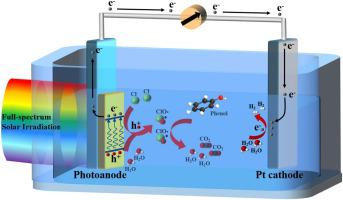Applied Catalysis B: Environment and Energy ( IF 22.1 ) Pub Date : 2021-05-21 , DOI: 10.1016/j.apcatb.2021.120387 Xin Li , Miao Kan , Tian Wang , Zhixiao Qin , Ting Zhang , Xufang Qian , Yasutaka Kuwahara , Kohsuke Mori , Hiromi Yamashita , Yixin Zhao

|
Photoelectrochemical generation of reactive chlorine species (PEC-RCS) is a promising approach for wastewater treatment. However, the inevitable byproduct of harmful oxychloride (such as ClO3− and ClO4−) severely limits the practical applications of full-spectrum solar-driven PEC-RCS systems. Herein, we investigated three typical photoelectrodes including TiO2, WO3 and BiVO4 for PEC-RCS system and the formation of RCS and toxic oxychlorides. In BiVO4 photoelectrochemical cell, the concentration of ClO3− was lower than 0.2 mg/L and the ClO4− was undetectable within 2 h of reaction. In contrast, the concentrations of ClO3− were 2.3 mg/L and 2.7 mg/L in the widely used WO3 and TiO2 PEC-RCS processes, respectively, which exceeded the health standard of 0.7 mg/L raised by the European Food Safety Authority (EFSA). We proposed that the valence band dependent photoelectrochemical properties of BiVO4 photoelectrodes could lead to the restricted HO· radical production and the non-HO·-mediated RCS generation, which synergistically inhibited the ClO3− formation in the RCS activation process.
中文翻译:

BiVO 4光阳极上光电化学反应性氯物种系统中ClO·的产生和氯酸盐的抑制
活性氯物质(PEC-RCS)的光电化学产生是一种有前途的废水处理方法。然而,有害酰氯不可避免的副产物(如CLO 3 -和C10 4 - )严重地限制全谱太阳能驱动PEC-RCS系统的实际应用。在这里,我们研究了三种典型的光电电极,包括用于PEC-RCS系统的TiO 2,WO 3和BiVO 4以及RCS和有毒氯氧化物的形成。在BiVO 4的光电化学电池,CLO的浓度3 -低于0.2毫克/升和CLO 4 -在反应2小时内未检测到。与此相反,CLO的浓度3 -分别为2.3毫克/升,并在广泛使用的WO 2.7 mg / L的3和TiO 2 PEC-RCS过程,分别,这超过了欧洲食品凸起的0.7毫克/升的健康标准安全机构(EFSA)。我们提出,BiVO的价带依赖性光电化学性质4光电极可能导致该受限制的HO·自由基产生和非HO·介导的RCS的生成,其协同地抑制CLO 3 -形成在RCS激活过程。


























 京公网安备 11010802027423号
京公网安备 11010802027423号